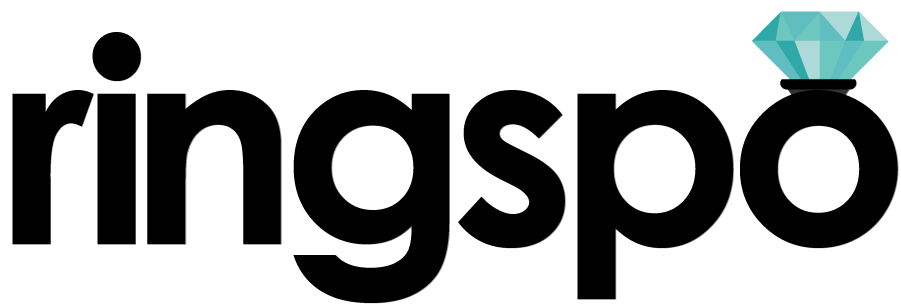Diamond Engagement Rings
Everything you really need to know. Nothing you don’t.
Ringspo is reader supported
Ringspo is reader-supported, which means we may receive a commission if you click a link to a retailer & subsequently make a purchase.
We feature links to several retailers to help readers find the one that is the best fit for them. Find out more about how Ringspo works here.
Diamond rings are the choice for 75% of all engagement rings for a reason – they sparkle brilliantly and their combination of beauty and resilience is a great metaphor for marriage and commitment.
But there’s lots of bewildering information out there, often supplied by jewelers who are trying to sell to you – it’s hard to know what really matters and what’s just sales spiel.
This post it going to talk you through absolutely everything that you actually need to know about buying a diamond engagement ring and how you can get the best bang for your buck and don’t get the wool pulled over your eyes.
We’re going to look at
- Engagement ring setting styles
- The 4 Cs of diamonds
- The different diamond shapes available
- Different metals you can choose
For each of these sections, you’ll be able to click through to other pages on the site which will go into much more detail as needed.
Let’s do this!
Engagement Ring Setting Styles
Much of the information that you’ll read about engagement rings jumps straight into the nitty gritty of how to get the best diamond for your ring. This is important and while getting it right isn’t all difficult if you follow some key principles, there are also many ways you can go wrong and spend more thamn you need to get an unimpressive diamond.
But before we jump into the technical info around diamonds, the first choice that needs to be made is what the ring actually looks like and this is determined by the ring’s ‘setting’.
A ring’s setting is the way that the center stone, and other stones are placed on the band.
It’s basically the ring’s format and style and it’s probably the most defining characteristic of any engagement ring. A recent survey gave ‘ring setting style’ as the number one thing that women care about with their ring – above diamond quality – so it’s the most important thing to get right.
Setting and its effect on budget
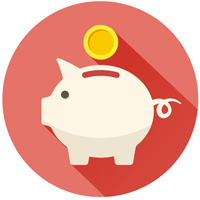
The setting you choose will determine how much budget you have left for the center stone and for the metal in the ring band.
If you go for a super-blingy ring setting with lots of diamonds inlaid into it, then this may mean that you need to go slightly smaller on the center diamond or choose 14 karat gold instead of platinum for the ring band to make sure that the ring fits into your budget.
Equally, going for a simple setting can mean that you have more budget left for a larger or higher quality center stone.
We’ll look at each of the main setting styles, and you can click through to find more information and more varieties of each.
Solitaire diamond rings
Solitaire settings are undoubtedly the most popular style of engagement ring setting out there. They’re a simple and classic design with a single center stone taking pride of place – usually a round or a princess cut diamond.
Because of their simplicity they’re usually the least expensive setting style. However, because there are no side stones to support the main stone, it means that the center stone is out there flapping in the wind on its own and has to do the impressing all on its lonesome.
Solitaires are held in place with either 4 prongs or 6. Four prongs allows the most light to enter the stone, which allows it to sparkle to the best of its ability. Six prongs, which is sometimes called the Tiffany setting because it was first produced by Tiffany & Co., holds the stone a little more securely but doesn’t allow quite so much light to enter it.
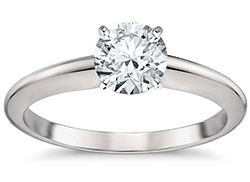
Bezel rings
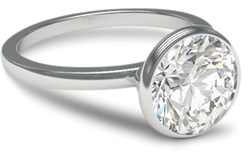
A bezel setting has a metal rim that surrounds the sides of the stone and sometimes extends slightly above it.
Bezel settings are very secure setting and their low profile mean that it’s suitable for women with active lifestyles – they don’t snagged and the bezel rim gives the stone great protection. Bezel settings are therefore also suitable for softer stones, like rubies, sapphires or emeralds.
Bezel settings use a little more metal than solitaire setting, but they’re usually priced similarly.
Channel set rings
Channel settings have a row of small diamonds inlaid into the ring band. Channelling can be added to any ring to give it a bit of extra bling – it’s often added to solitaires to give it a bit of extra sparkle and can be a great option if you are struggling to stretch to a large center stone.
One thing to watch out for is that you don’t get the wool pulled over your eyes by someone quoting the ‘Total Carat Weight’ or ‘Total Diamond Weight’ for a ring. A ring with a CTW of 1.1 carats may only have a center stone of 0.7 carats, with the remainder made up of the smaller channel stones, and should be significantly less expensive than a ring with a center stone of 1.1 carats.
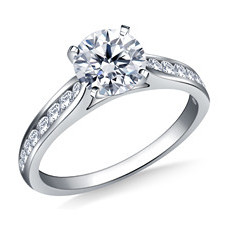
Pavé diamond rings
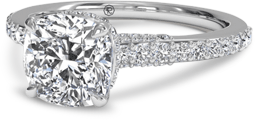
Pavé (pronounced pa-vay) is basically a ring paved with diamonds – lots of small diamonds covering the whole ring, including sometimes the underside of the band.
It can be a good option to support a smaller center stone, although the cost of the increase in complexity and the number of supporting stones usually matches the reduction in cost from the smaller center stone. One way to reduce the budget is to go for a ‘half pavé’, where only the top half of the band has stones in it, while the bottom is plain.
Three stone diamond rings
The advantage of a three stone setting is that you can get a higher carat weight of diamond for a much reduced price e.g. three 1/3 of a carat stones on a ring would be much less expensive than a single one carat solitaire.
Changing the shape of the side stones, or even the type of stone (ruby, emerald and sapphire all work well) can give an almost endless number of varieties of three stone ring.
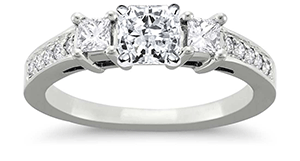
Halo engagement rings
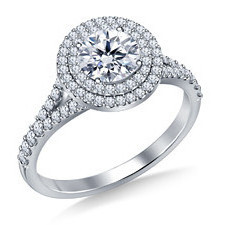
Halo settings surround the center stone with a halo of smaller pavé diamonds. The halo setting is another good way of making a ring with a smaller center stone look more impressive, although the high number of diamonds used can increase the price of the setting considerably.
Again, there are many combinations of style and stone for the halo setting, with single, double or even triple halos available and different combos of diamonds and other precious stones..
Buying unmounted
If you’re a guy and you’re finding that choosing the setting is just too much pressure for you (and I don’t blame you if it is!), then there is a way that you can get her input in to the choice of setting and still keep the proposal a total surprise.
It is possible to just buy a diamond on its own, which you can then buy the setting to match later.
The beauty of this is that you can still drop to one knee, pop open the box lid and knock her socks off with a shiny sparkler, but you can then spend time with her choosing the setting that she has always wanted – taking huge amounts of pressure off you and making sure that she will definitely always love her ring.
Getting inspiration
If you’re not sure where to start, then a gallery of recently purchased engagement rings can be a great place to start.
Filtering by style, diamond shape, precious metal type etc can quickly help you narrow down what you’re looking for.
The 4 Cs
You’ll hear a lot about the 4 Cs while you’re looking for an engagement ring, maybe you already have. Basically the 4Cs are measurements of key characteristics that are recorded on a certificate that should accompany every diamond.
The 4Cs are graded by independent laboratories and are key to knowing the quality of the diamond that you’re assessing. The 4Cs are:
- Cut
- Color
- Clarity
- Carat
What jewelers won’t tell you is that not all Cs are born equal and there are a couple that knowing a bit of inside information about can save you some serious cash.
In this section we’ll look at each in turn, including how to make sure that you get the most from your money.
Diamond cut
Diamonds come out of the ground as rough chunks of carbon that are often pretty dull to look at. Cut is a grading of how well a diamond has been cut and polished from this rough state into the shiny bling that you’re looking for with your ring.
The cut ‘score’ that a diamond is given depends on the proportions of the stone, which are key because they control how much light the diamond reflects back to your eyes and therefore how much the stone sparkles. It’s the most important of the 4Cs and the one that you should definitely not scrimp on.
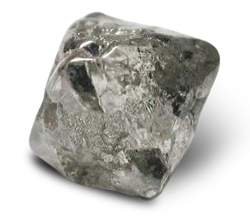
The cut score was developed for round diamonds, but retailers often apply their own cut score to other diamonds shapes too. Here’s how the scale works:
- Excellent cut: Restricted to the top 3% of diamond quality. They reflect nearly all light to give the brightest sparkle. We recommend you choose this.
- Very good cut: The top 15% of diamond quality. While not as high quality as the ‘ideal’, they reflect nearly as much light, at a lower price.
- Good cut: Top 25%. Reflects most light and is significantly less expensive than ‘very good’.
- Fair cut: Top 35%. Still decent quality, but noticeably less brilliant.
- Poor cut: All of the rest! Diamonds that are so deep or so shallow that they lose most of the light out the sides and bottom.
Diamond is cut too deep
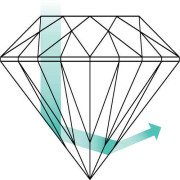
If a diamond is cut too deep the light will be reflected off the bottom of the stone at the wrong angle, rather than back to your eyes.
This will make it appear smaller from the top and can result in a dark shape appearing in the center of the stone. This is known as a ‘nailhead’.
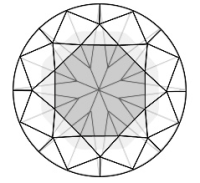
Diamond is cut too shallow
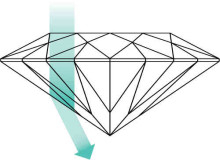
A diamond that is cut too shallow will allow more light to pass straight through it and leak out the bottom, again, making it appear less brilliant:
A shallow cut diamond can result in an effect called a ‘fisheye’, so called because a dark ring will appear on the top of the rock resembling the cold dead eyes of a haddock before it meets its final resting place – a bed of chips, liberally doused in salt and vinegar.
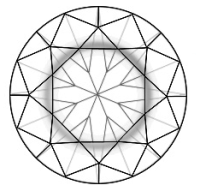
The nailhead and fisheye effect can completely ruin a stone that scores highly in all of the other diamond scoring criteria, and avoiding them is a huge reason for choosing a high cut rating.
Diamond’s proportions are just right
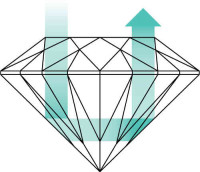
A diamond cut to ‘excellent’ or ‘ideal’ proportions (the term used can vary between retailers) will reflect as much of the light that enters the diamond back to your eyes, resulting in the incredible fire and sparkle that you want from your diamond.
To make sure that your diamond sparkles as brightly as possible, always go for excellent / ideal cut. Cut is definitely the most important of the 4Cs, and it’s worth sacrificing higher grades on the other Cs to make sure that you can get as high a cut grade as you can within your budget.
Diamond color
The color of most diamonds lies somewhere on a scale from pure white through to yellow, with some rare diamonds being found in other colors too (brown, pink and others).
The closer to white a diamond is, the more rare is it, and as I’m sure you’ve guessed by now, the more rare something is, the more expensive it is. The color scale looks a little something like this:

As there are so many increments on the scale, the difference between each of the grades is very small and pretty much imperceptible to the untrained eye.
While a diamond ranked as F on the scale is classified as ‘colorless’ and a G is only ‘near colorless’, you or I wouldn’t be able to tell the difference and sometimes even trained gemologists can’t.
The two diamonds below the difference between the very top grade – D – and a diamond with G color.


Although you can see a tiny difference in shade between the two pics, they are both very white stones and the G color would look perfectly white once set in a ring setting.
It’s a bit like buying two white shirts from two different stores. You may be able to see a tiny difference in the shade of white if you put them next to each other, but if you saw them individually, they would both just be very white shirts.
For ‘brilliant cut’ stones (round, Princess cut, oval) then you can go to color grade H and your stone will still look perfectly light. For all other shapes, color G is the cut off and below this some ‘warmer’ tones may be visible. This is perfectly acceptable and some people prefer the warmer tones of J-L colored stones.
Have a play with the color sliders here and you’ll quickly see that moving them just one grade doesn’t make much difference, but if you start to move them 3 or 4 grades, the change is more obvious.
Diamond clarity
The third C, clarity, is a measure of the number of flaws that a diamond contains. The flaws are also known as ‘inclusions’ and are tiny impurities that snuck in when the diamond was being formed.
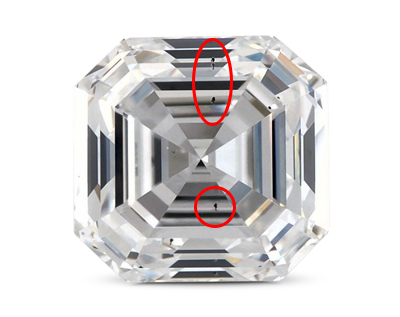
With diamonds, most flaws are invisible to the naked eye and a microscope is needed to see them.
However, jewelers love to show people diamonds under a microscope to highlight the difference between the different clarity grades.. and when you see the inclusions under a microscope, it’s easy to view clarity as the key differentiator of diamond quality and get caught up in wanting the diamond to be as pure as possible.
But! Clarity actually makes very little difference to the appearance of a diamond. It’s graded using the scale below and it’s worth you having a read of the descriptions:
| Acronym | Description | Traits |
|---|---|---|
| FL | Flawless | Extremely rare, with only a few hundred found each year |
| IF | Internally Flawless | Only external flaws are present, which can be removed by further polishing the stone |
| VVS1 | Very Very Slightly Included 1 | Only an expert can detect flaws with a 10X microscope when examining the stone from the bottom. |
| VVS2 | Very Very Slightly Included 2 | Only an expert can detect flaws with a 10X microscope when examining the stone from the top. |
| VVS 1-2 | Very Slightly Included | You can see flaws with a 10X microscope, but it takes a long time (more than about 10 seconds) |
| SI1 – SI2 | Slightly Included | Flaws can be seen easily with a 10X microscope and they may be visible with the naked eye if you examine closely |
| I1-I3 | Included | Flaws can be seen easily with the naked eye |
The thing to take away from the table is that while flawless diamonds have no inclusions at all, it’s only when you get right down to the ‘Slightly Included’ that there is a chance that you can actually see them with the naked eye. Above this grade, the every diamond will look absolutely perfect when it’s looked at with the naked eye.
So unless you’re planning on showing off your newly purchased engagement ring to people and asking them to examine it under a microscope, it’s not worth incurring the extra cost of going for a diamond that scores highly on the clarity scale if the microscopic flaws are impossible to see.
How diamond clarity affects price
To show how clarity affect the prices you pay, I conducted an experiment with one of my recommended retailers. I kept all the characteristics of a diamond the same and only changed the clarity grade.
The characteristics of the stone that I used were:
- Shape: Round
- Cut: Excellent
- Color: F
- Carat weight: 1 carat
| Clarity | Price (USD) | Difference (USD) | Difference (%) |
|---|---|---|---|
| F | $9,988 | $0 | 0% |
| IF | $8,408 | -$1,580 | -15.8% |
| VVS1 | $6,628 | -$3,360 | -33.6% |
| VVS2 | $6,359 | -$3,629 | -36.3% |
| VS1 | $5,960 | -4,028 | -40.3% |
| VS2 | $5,434 | -$4,554 | -45.6% |
| SI1 | $4,698 | -$5,290 | -53.0% |
| SI2 | $4,104 | $5,884 | -58.9% |
| I1 | $3,879 | -$6,109 | -61.2% |
Looking at the table you can see that there’s an absolutely huge difference between the top and the bottom ranking – over 50%. However, the bottom ranking for clarity is definitely to be avoided – it means that flaws are visible with the naked eye.
The best two gradings to consider are either VS2 or SI1. Choosing either of these two grades will land you a whopping 45%+ discount on a ‘Flawless’ stone, but unless they are compared under a microscope, no-one would be able to tell the difference between them.
VS2 stones will all be ‘eye-clean’ which means that you can buy them without examining the individual stone, knowing that there will be no inclusions visible. SI1 stones might be eye-clean, but may also have some small inclusions visible. The only way to tell is to examine the individual stone. The two best online retailers to do this through are:
Click through and have a play with the diamond prices yourself to see what a huge difference the clarity can make.
Diamond carat
The fourth and last of the official four Cs, carat is the weight (rather than the ‘size’) of a diamond.
Two diamonds with the same carat weight can have different dimensions, like the two below, so appear very different in size.
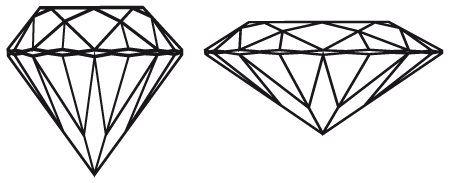
Each carat is divided into 100 smaller units, called points – basically the percentage of a carat. Confusingly, the measurement of purity for gold is the similarly named ‘karat’, with a K. However, the two scales are unrelated.
Carat is another factor that has a huge effect on the price of a ring, so how big you go depends on how much you are willing to spend. Theknot.com has conducted a survey which provides some useful benchmarks on the average size of engagement ring in the US – you can see the results in the pie chart on the below:
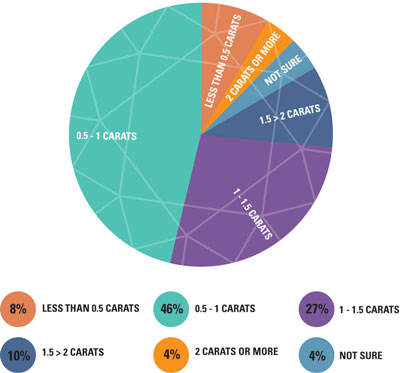
The biggest section of the pie is between 0.5 carats and one carat, and if you’re going for a solitaire setting which features only the center diamond then a 0.7 carat is a good place to start. Being smart with the other factors of the 4Cs can mean that a 0.7 carat stone can be quite affordable.
The second largest slice of the piechart is a much narrower band of sizing – one carat to 1.5 carats. The large concentration of rings bought within this small band shows that a large number of people are aiming for a ring at the magical one carat mark – people want to be able to say that they have a one carat ring. 0.95 carats just doesn’t have the same, er, ring to it.
Magic weights
There are certain weights that are seen as landmarks – 0.5 carats, 0.75 carats, 1 carat etc. Jewelers know that these ‘magic’ weights are desirable, so the price of a stone that is just above them will be disproportionately higher than one that is just underneath. By dipping down to just below a magic weight, you can save yourself some more cash without the difference in weight being noticeable.
Ultimately, the size you go for is up to you, but by following the advice on this page when it comes to shape and clarity, you should be able to increase the size of the carat you can afford. The golden rule to stick to is: never compromise diamond cut for carat weight. Always go for the very best cut grade that you can.
Certification
Not an official ‘C’, but definitely very important, a certified stone is one that has been assessed and graded by an independent lab and has a certificate to prove it. Each certificate has a unique report number and detailed information about the stone, covering the four Cs, the height, depth and other info.

It’s essential that every diamond that you consider has been assessed by an independent authority – never consider a stone without an independent grading report because you will have no idea how accurate the grading is.
The labs to trust are the GIA (Gemological Institute of America) or AGS (American Gem Society). Other diamond labs have reputations for inflating grades for diamonds, which means that lower quality diamonds can be sold at higher prices. Always look for a GIA or AGS certificate and never just rely on the opinion of the jeweler.
DIAMOND SHAPES
Most diamonds used in engagement rings are the ’round brilliant’ cut – like the pic on the right. It’s almost the default setting for diamonds, but definitely isn’t the only choice.
Their popularity makes round brilliant diamonds by far the most expensive shape and by choosing one of the other shapes there are considerable savings to be made. Other, less common shapes can make your engagement ring more individual, as well as saving you considerable amounts of cash too.
The 10 most common shapes for diamonds are below, and you can click through on each to find out much more information about each one.
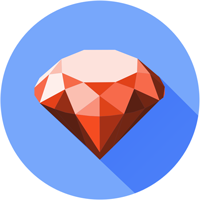
Round brilliant:
Starting with the most popular, the round brilliant is shaped to reflect as much light as possible. Round brilliants are the most popular, most sparkly, but most expensive of all diamond shapes.

Princess cut:
The second most popular shape, the Princess cut is also a ‘brilliant’ cut, and a well-cut Princess cut diamond will sparkle nearly as brightly as a round brilliant diamond, but cost considerably less.

Oval:
The oval is basically a stretched round brilliant and offers a similar level of sparkle at a much reduced price, while also looking slightly larger due to its elongated shape. Win-win all round!

Marquise:
A classic diamond shape that originated in the 17th Century, the Marquise is a less fashionable than some other shapes at the moment, but can make for an elegant and uncommon engagement ring.

Pear:
The pear is a combination of the oval and the Marquise shape. It works well when worn with the point forward, which makes a finger appear slimmer.

Heart:
One for the Barry Whites out there, the uber-romantic heart shape is actually pretty rare due to the difficulty of getting the cut right.

Cushion:
Before the round brilliant shape was invented, the cushion was the default diamond shape. Modern cushion cuts now sparkle nearly as much as brilliant cut diamonds at a lower price and can be used in a wide variety of ring setting styles.

Emerald:
Emerald cut diamonds are a classy and elegant shape – they’re a great match for vintage or Art Deco-style engagement rings. While they don’t sparkle in the same way as a brilliant cut stone, they instead reflect bright ‘flashes’ of light.

Asscher:
With its ‘stepped’ sides, the Asscher shape is a bit like a square-shaped emerald cut. Another classic cut, it’s gaining in popularity as several Hollywood stars have chosen it for their engagement rings.

Radiant:
The radiant shape has a great combo of the elegance of the emerald or Asscher cut and the incredible sparkle of a brilliant cut. A less common, but much more individual choice for a center stone.

Diamond shape’s effect on price
For a guide to how shape affects price, I looked at one of the jewelers from my recommended retailers section and conducted a quick test – keeping all the other characteristics of the diamond (colour, clarity and carat) the same and only changing the diamond shape.
- Cut: Excellent
- Color: G
- Clarity: VS2
- Carat: 1
The results are actually pretty mind-blowing:
Choosing any shape other than a round brilliant gives at least an automatic 20% drop in price and a shape like the cushion, is nearly 40% less expensive than a round diamond at the exact same size and quality. Depending on the size and quality of the diamond that you are looking at, these changes will vary but there will always be a significant saving available.
| Name | Shape | Price (USD) | Difference (USD) | Difference (%) |
|---|---|---|---|---|
| Round | $5,434 | 0 | 0 | |
| Oval | $4,180 | -$1,254 | -23.1% | |
| Pear | $4,150 | -$1,284 | -23.6% | |
| Princess: | $4,072 | -$1,362 | -25.1% | |
| Marquise | $4,030 | -$1,404 | -25.8% | |
| Heart | $4,028 | -$1,406 | -25.9% | |
| Asscher | $3,650 | -$1,784 | -32.8% | |
| Radiant: | $3,520 | -$1,914 | -35.2% | |
| Emerald | $3,440 | -$1,994 | -36.7% | |
| Cushion: | $3,240 | -$2,194 | -40.4% |
The money you save on choosing the shape smartly can be put towards other attributes to the ring. Or, y’know, a weekend in Vegas..
Where should you buy from?
Fifteen years ago, all rings would have been bought from bricks and mortar jewelry stores. Guys would have toddled off with their wallets bulging with three months’ salary and taken their pick from the limited selection available. Now with the rise of e-commerce there are other routes to market for diamonds, which give you more options than ever before.
Buying from a jeweler
Buying from a jeweler is the most traditional option and it has a few advantages. You can gauge the quality of the shop from its appearance, you’ll be able to compare different stores’ wares, you can ask sales staff questions and you should be able to examine any diamond through a loupe, or even a microscope.
If you’re in a major city, there are often clusters of jewelers, which makes the comparison even easier. Once you know what you’re looking for, you can take the specs to each jeweler and see who has the best match and the best price.
Something to watch out for is that in a jewelry store you will often be sold to, rather than being able to browse without pressure from a salesperson. Jewelers are well versed in sales tactics and use artificially bright lighting to make their stones look as bright and attractive as possible, hoping to dazzle you into buying from them. Here’s a post about sales tactics to watch out for.
When you’re looking for a jeweler, you want one that specializes in diamonds, or the precious stone that you’re looking for, rather than a generalist. If they have cabinets of crystal decanters and sell fashion designer-branded watches then you should avoid them. A few questions to consider when selecting a jeweler:
- Do they offer GIA or AGS certification with their stones?
- Do they offer a written money-back guarantee? Reputable jewelers should offer a cooling off period after purchase
- Will they let you examine a diamond under a microscope, rather than just through a jeweler’s loupe?
- Do they have a full-spectrum diamond light to let you judge the colour grade?
- Do they offer clarity-enhanced diamonds? Most respectable diamond specialists don’t.
Bricks and mortar jewelers may have a very limited selection of stones on-site, so if you are going to use your new knowledge of diamonds to request a particular combination of cut, color, clarity and carat, it’s very unlikely that they will have it in-store. Requesting a diamond with a particular spec and then waiting for it to be delivered from the wholesaler for you to examine can be a frustratingly slow experience.
Online retailers
Online has completely revolutionised buying an engagement ring and in my opinion, it’s definitely the way to go. Many sites list entire wholesalers’ inventories – hundreds of thousands of stones – giving you instant access to a huge choice that a store could never match.
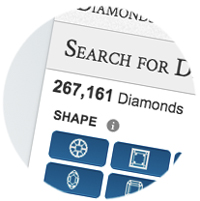
The best sites have tools to allow you to adjust the four Cs until you find the best diamond for your budget. This means that you can play with the variables using your new knowledge and find the exact engagement ring that you are looking for, rather than having to settle for what a shop has in stock that day or what they can get you in two weeks time.
Something that many people don’t know is that many jewelers share inventories of diamonds so the same rock can be bought from multiple outlets.
Incredibly, some jewelers charge twice as much for the exact same stone, which means that it’s really important to compare the prices between jewelry retailers. This blog post shows how one emerald cut diamond is being sold for over $10,599 by a mall jeweler and $5,336 by an online retailer – a pretty scandalous difference.
Our list of recommended retailers all offer these search tools and even if you think you are going to buy from a bricks and mortar store, I’d really recommend that you have a quick look to conduct a quick price comparison. The difference will probably surprise you!
Buying a diamond online works because every stone has already been reviewed and graded by an independent expert. You can use the certification and magnified images that some retailers provide to tell you much more than you could learn about a stone from a quick look in a jewelry stone.
And buying online you can take your time to research the perfect diamond and ring and make sure that it fits within your budget, making an informed choice to get your perfect ring at the best possible price.
So what should you choose?
There are an almost infinite number of combinations of diamond shape, color, clarity, size and ring setting styles, so it’s understandable if it’s a little overwhelming to begin with.
Ultimately the perfect ring for you is all about finding a combination of each of the characteristics of an engagement ring that you love that works within your budget.
The information on this page is a great starting point, but I’d encourage you to read more of this site to make sure that you understand what does and what doesn’t make a difference to the appearance of a diamond. Without that knowledge, it’s easy to get caught up in wanting to get a high ‘quality’ diamond and paying over the odds for characteristics which don’t make any difference at all to how impressive your ring is.
That part of your budget could easily be diverted to other characteristics which really DO make a difference to you ring. Or, you could even end up spending less than you originally intended on your ring which could go towards planning an awesome proposal, your wedding budget or an incredible honeymoon.
Learn more about the 4Cs
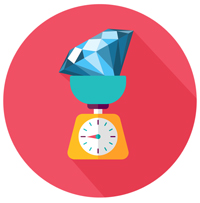
Carat
Find out why biggest isn’t always best

Clarity
How to avoid paying over the odds

Cut
Find out why it’s the most important C

Color
Make sure your choice makes a difference
